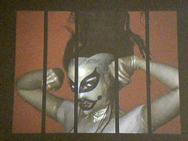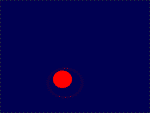 |
Instead of writing a normal review, I must start
by enjoining you to rush right down to Participant, Inc.
253 East Houston Street, New York, in the Lower East
Side, to view the video which dominates the show. It's
called "99", and it's by Charles Atlas -- not the body-
builder in the back of ancient comic books or the rock
band, but a video artist and film director. (See this
article
in PBS's Art:21 for a biography.) The show is up
for only another week (until Sunday, June 20) as I am
writing this.
In this video (from which I have taken the stills
which illustrate this article, which however in no way
do justice to the original) the screen is divided
into five panels. The subject, a dancer named Johanna,
is seen, but only her head, shoulders and arms appear.
She turns slowly; she is probably on a turntable of
some kind, since the motion is completely smooth.
She is wearing a mask and is made up, indeed face-
painted, in what has come to be called "tribal"
patterns when it's done with tattoos. As she turns,
she moves her hands and arms through various gestures
which are not like a human imitating a cat or a cat
imitating a human, but rather in the spirit of a
cat -- the way a cat might gesture if it were given
a human body. One hears an
audio track which consists of two sounds; one, a
steady, sharp, slow percussive beat that might be made by a
separate hard taps on a drum or block; and second, the
sound of a very large bell. As the video progresses,
an interesting thing occurs: the five panels
gradually go out of sync, so that now we are
seeing not one but five different "times" of the
dancer at once. As the video nears its end, the
panels come back into sync and then the pictures
fades out.
There is a second video, in which the same dancer's
head is seen with what are apparently electronic
parts, integrated circuits, attached to it; the
dancer counts to ten, whereupon (sometimes) the head
seems to explode. My take on this was that it was a
kind of humorous conflation of "counting to ten", a
proverbial expression of barely restrained anger,
and counting to ten and other numbers as electronics
do -- perhaps our computer are very angry. However,
one sees so much exploding electronic merchandise in
movies, television and videos that the effect is
someone diminished by familiarity.
"99" -- the Cat-woman -- on the other
hand was profoundly moving to me because, I think,
it recalled traditional or classical dance,
especially that of southern and eastern Asia,
which is strongly ritualized and stylized. As
Verdi is supposed to have said, we go backward in
order to go forward; that is, in the arts, we must
often revisit decisions made long ago which have
dominated practice ever since. Although artists
from Lascaux until the latest webcomic have had no
objection to simultaneously presenting the same
object from different angles or at different
times, the Greeks and their Renaissance followers
thought that it was more elegant to find the
moment at which the past and future, the before
and behind, were summed up
and balanced in a kind of repose implying (they
hoped) a whole temporal, spatial and dramatic universe
in a single coherent instant. Thus the
figure of the Discobolos is seen at the very
moment when his windup ceases and he is about to
begin moving forward to throw the discus. But
this was actually a rather specialized approach;
all over the world, for ages, artists trying to
show the passage of time or a variety of
viewpoints simply drew the different images side
by side or on top of one another. The repute of
the Greeks seems to have caused this to have been
forgotten in the modern West for awhile. So in the
twentieth century, (comics and movies being at
first considered too vulgar to worry about) when
Duchamp presentedNude Descending A Staircase
people were either shocked or derisive; they had
forgotten the strategies of their ancestors.
Of course a video or movie is already stretched
out in time; in this it is like music. However,
the mass-distribution movies which form the default
practice of our culture are still generally fixed
to one certain point of view at a time, and segments
of a single-threaded sequence of events. It is
considered rather avant-garde to
show two or more image sequences at once, either
side by side (Chelsea_Girls) or through very
rapid intercutting (The Pawnbroker). (A similar
restraint occurs in music, where the polyphony of
Palestrina or Bach, the simultaneity of Charles
Ives, or the polyrhythms of traditional African
music, are rarely acqired tastes, although some
popular or garage artists have begun to sneak up on the
public with such practices, and classical composers
have always used them in the background,
at least playing supporting roles.) In the case of our
Cat Woman, we see five (and sometimes more) panels
showing the dancer at difference stages of her
performance. As gestures and views proliferate
and collapse, she sometimes becomes multi-faced
or multi-armed, like a Hindu goddess; or her
disembodied gestures float through the dark
background of her surroundings.
Obviously the low-res stills on this page can
give only a very reduced idea of the effect of
the video when it is showed at full size, at
high resolution, and with a performance-sized
sound system. It must be seen and heard
directly.
And now about the rest of the show.
The show, which is called "Dead Flowers", focuses
on avant-garde art which, in contrast to the
popular narrative arc, did not come from behind
to overwhelm the world
and turn its practitioners into fabulously
wealthy demigods whose names were known in every
household. The words come from a Rolling Stones song,
famous
long ago, 1969, to be exact:
Take me down, little Susie, take me down,
I know you think you're the queen of the Underground,
And you can send me dead flowers every morning,
Send me dead flowers by the mail,
Send the dead flowers to my wedding,
And I won't forget to put roses on your grave.
But what is, or was, the Underground? There has
to be a ground for there to be an underground.
Beginning in the early part of the 20th century,
popular culture became dominated and informed by
the facts of capitalist industrial production. If
you listen to the Harry Smith Anthology of
American Folk Music, you will hear dozens of
different style and themes. After about 1925 or
1930, everything "country" sounds like Jimmie
Rodgers. That is because the conditions of
production in that era made making many copies of
a few exemplars more profitable than anything
else, indeed, it was just about the only way a
music publisher could stay financially viable. As
long as only one at a time could speak to the
many, whether that one was a publishing company, a
record company, or a radio station, these
conditions of production remained the same and
popular culture revolved around a few genres,
a few stars. These conditions, along of course
with various social forces like
bourgeois respectability and the law, created a
"ground" beneath which cultural facts were not
generally visible or respectable. Indeed, they
were hardly visible in the darkness even to those
themselves "underground".
Under such conditions only a few could rise
into visibility -- the popular story of such as
A Star Is Born or Jailhouse Rock and
of many factual narratives as well. A more general pattern is
that of the hero who waits in the wings of life for
his chance, usually while performing prodigies which
for some reason no one notices until the moment
of recognition and apotheosis arrives.
But life, including the lives of an artist, isn't
always like that. Van Gogh famously toiled in
relative obscurity throughout his short, troubled
life and died without having sold anything. It was
only the very laborious work of his brother's widow
over a period of 20 or 30 years that caused people
to finally see his work. Who knows what other
treasures still lie hidden in the realms of Pluto?
So Persephone may be sending us dead flowers
from the Elysian fields.
The present show centers around the work of the
actor and director Timothy Carey, and consists of
a series of screenings of films which are
unreleased as of the present, for which the other
material is on display as support. Charles Atlas's
video, for example, connects with a large sign
reading "The World's Most Exciting Dancer" and
a photograph of an old-time (1962) roadhouse advertising
an exotic (that is, erotic) dancer named "Catgirl" -- thus connecting
high and low art as well as the present and the past,
the reputable and the disreputable.
A full schedule
can be seen on Facebook:
http://www.facebook.com/pages/PARTICIPANT-INC/123615784318865
Carey worked in commercial films as a "secondary character
actor" and when he got some money, he put it into his own
independent projects, some of which will be seen in this
series. He did not consider himself to be
part of an "underground" (a concept which, in the 1960s,
was already going overground as a marketing tool) but
did labor in relative obscurity. In the fall, Participant
intends to present more of Carey's films.
(To be continued....)
|

